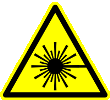
Limitations of Laser Communicators

 |
Limitations of Laser Communicators |
 |
Some writers use tight-beam laser communicators as a panacea for the problem of secure communications in their science fiction stories. I couldn't help but think that this might not necessarily be so, so I have looked into it a little.
From what I can find a collimated laser beam is the best for communications, as it diverges the least. However, without invoking some sort of technological magic outside of what is currently known of physics, a perfectly collimated beam cannot be created, due to diffraction. Thus all laser beams diverge, at least to some extent.
As a best case, that is one with the least divergence, a perfect laser beam will diverge by a factor of 1.414 (the square root of 2) over a distance given by the Rayleigh Length, which is given by:
rayleigh_length = |
π * beam_radius2 laser_wavelength |
For a 1 metre diameter laser emitter, this means that beam width as a function of laser wavelength at different distance from the emitter is as shown in the table below.
| EM Radiation | Laser Wavelength | Width of Beam at Given Distance (metres) | |||||||
| 100 km | 1000 km | 10000 km | 100000 km | 1 Mkm | 10 Mkm | 100 Mkm | 1 Gkm | ||
| X-rays (Short) | 0.01 nm | 1 | 1 | 1 | 1 | 1 | 1 | 3 | 19 |
| X-rays (Long) | 10 nm | 1 | 1 | 1 | 3 | 19 | 181 | 1802 | 18007 |
| UV | 100 nm | 1 | 1 | 3 | 19 | 181 | 1802 | 18007 | 180064 |
| Blue Light | 400 nm | 1 | 2 | 8 | 73 | 721 | 7204 | 72026 | 720254 |
| Red Light | 700 nm | 1 | 2 | 14 | 127 | 1261 | 12605 | 126045 | 1260444 |
| Near IR | 0.001 mm | 1 | 3 | 19 | 181 | 1802 | 18007 | 180064 | 1800634 |
| Thermal IR | 0.1 mm | 19 | 181 | 1802 | 18007 | 180064 | 1800634 | 18006327 | 180063264 |
| Microwaves | 1 cm | 1802 | 18007 | 180064 | 1800634 | 18006327 | 180063264 | 1800632633 | 18006326324 |
So a short-wavelength x-ray laser communication beam will still be pretty small at a billion kilometres, at perhaps 19 metres in diameter. However, the aiming of such a beam at a moving target from a moving source and keeping it there will be pretty horrendous. It would only take a rotation of the transmitter of 1.1 nanodegrees to shift a point target outside the beam; this is equivalent to tracking a moving target of the thickness of the thickest human hair at a distance of nearly 9470 kilometres. I imagine such accuracy would be do-able, but hard.
A UV laser, on the other hand, would be some 180 metres across before it gets to a million kilometres out, so it is quite likely that at least some of the beam will go past the target and so be detectable behind it. On the other hand it requires a rotation of the transmitter of some 10 microdegrees to shift a point target outside the beam; this is equivalent to tracking something of the thickness of the thickest human hair at a distance of some 995 metres.
The further away you go and the shorter the beam wavelength the more this tracking problem grows.
Making your laser beam have a smaller diameter only gets you so much as the divergence quadruples for each halving of the beam diameter, while doubling the beam wavelength only halves the divergence. Thus shorter wavelength, large diameter transmitters would be the best for a collimated beam, but transmitting wide laser beams through space obviously has problems of its own in terms of detectability.
I guess ideally what you want would be a large diameter laser emitter on your transmitting ship to allow a finely collimated beam to be transmitted to the sensor drone or whatever in the target area (though of course this has the problem that is is a large diameter beam and so is detectable because of this). The drone or whatever that is transmitting back, if it has to worry less about being detected (for example if it is transmitting away from the enemy), can get away with a smaller diameter, and so a more diverging beam.
Send any comments to me at tony {dot} website {at} clockworksky {dot} net.
My Roleplaying Page | My Science Fiction Page | My Home Page.
Ideas on using HTML to write equations from Mathematical Recreations.
Laser hazard symbol from Wikipedia.
 |
Copyright © Tony Jones, 2010.
This work is licensed under a Creative Commons Attribution-Noncommercial-Share Alike 3.0 License. |